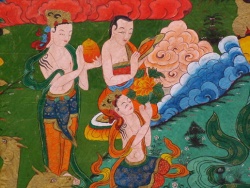The Search for Shambhala
In 880 BC, the Buddha is reputed to have relayed the Kalachakra Tantra – a complex system of philosophy and meditation for attaining enlightenment - to sect of followers in Andhra, India. This document, later adopted by Tibetan Buddhists and elaborated upon in a series of subsequent manuscripts, speaks in depth of a kingdom called Shambhala – an paradise where only most spiritually resplendent of beings can reside.
Though the texts depict Shambhala as physical city-state – one with a lotus-shaped perimeter divided into 96 districts and ruled over by a specific chronology of kings – they also maintain that it is separated from the tangible world by a spiritual boundary. As the Dalai Lama stated in 1981, “[If] you lay out a map and search for Shambhala, it is not findable; rather it seems to be a pure land which, except for those whose karma and merit have ripened, cannot be immediately seen or visited.”It is the goal of all Tibetan lamas to one day, after years of intense study and reflection, to perceive the awesome grandness of this ethereal oasis through the achievement of enlightenment and the cycle of rebirth.
Nonetheless, that did stop rumors of Shambhala’s supposed material riches from slowly seeping into Western Europe, due to increased academic interest in Buddhism in the mid-18th Century. Much like the Spanish conquistadors led astray legends of the golden city of El Dorado or the Fountain of Youth, embellished tales of Shambhalah as a lost city populated by god-kings, oracles and an endless caches of jewels quickly spread through less discerning circles.
Would-be treasure hunters, however, were quickly felled by contradictory accounts of the holy city’s location. Various sources-including some from within Tibet itself-placed Shambhalah at different points throughout Central Asia. Nepal, the Gobi Sea, India and Siberia were, at one time, all considered likely prospects. Such gossip only served to deepen the legend’s mystique to fringe groups of esoteric devotees and occultists, who fixated on the idea of Shambhalah as the last refuge of a lost civilization or intelligences from beyond the plane of human existence. In Germany, some proto-Nazi organizations, such as the Ariosophists, speculated that Shambhalah was the birthplace of Aryan race and viewed it as an analog to the Asgard of Norse mythology.
Drawing from these conclusions, Heinrich Himmler deployed as an SS unit to Tibet in May 1938 to not only collect data and artifacts that supported those views on Aryan lineage, but also substantiate rumors of Shambhalah’s existence. Within six months, the squad completed the arduous task of reaching the Tibetan capital of Lhasa - but would eventually fail to locate their mythical conquest before returning to Germany.
Luckily, the Tibetan manuscripts themselves do provide some insights - in the form of prophecy - as to when Shambhalah will be revealed once and for all time. In an interesting counterpoint to the Bible’s Book of Revelation, the Kalachakra Tantra that states that the world of man will eventually degenerate through war, greed and moral corruption. At that point, a tyrannical ruler will ascertain the kingdom’s true location and invade, only to be fought off and defeated by the 32nd King of Shambhala, Rudra Cakrin, and his army of the pure hearted. In doing so, the world will be ushered into an age of enlightenment and unprecedented global unity.
Not so luckily for us, however, is the fact that the Tibetan calendar places the date of this transformation in the year 2425.

